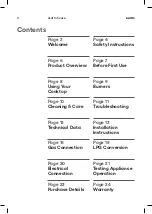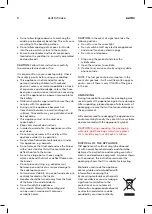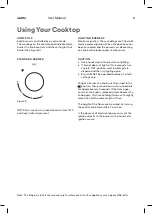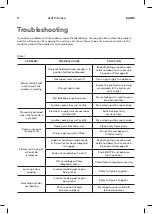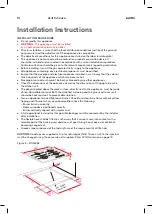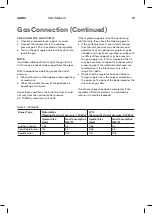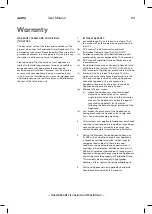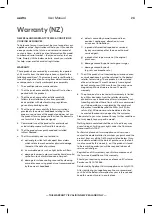
esatto.house
15
Installing the appliance
Sponge
Bottom view
The thickness of the sponge is 3 mm.
The width of the sponge is 10 mm.
of the screws.There are one set of screw holes in each
corner of the hob
(H)
.
Slightly tighten a screw
(C) through the bracket
(B) so
that the bracket is attached to the hob, but so that you
can still adjust the position .
.
2 Carefully turn the hob back over and then gently lower
it
into the aperture hole that you have cut out.
.
3 On the underneath of the hob, adjust the brackets into
a
position that is suitable for your worktop.
Then fully tighten the screws
(C) to secure the hob into
position.
(A) SEALING STRIP
(C) SCREW
(B) BRACKET
17
Remove the pan supports, the burner lid
and flame spreader and carefully turn the
appliance upside down and place it on a
cushioned mat.
Take care that the Ignition devices and
flame
supervision devices are not damaged
in this operation.
2. Apply the sponge provided around the
edge of
the appliance.
3.
1.
Do not leave a gap in the sealing agent or
overlap the thickness.
3ODFHWKHEUDFNHW
%RYHUWKHKROHVWKDWPDWFKWKHVL]H
7KLVZLOOPDNHLWGLI¿FXOWWRUHPRYHWKH
DSSOLDQFHIURPWKHDSHUWXUHLQIXWXUH
SDUWLFXODUO\LILWQHHGVWREHVHUYLFHG
Do not use a silicon sealant to seal the
appliance against the aperture.
(A) SEALING STRIP
(B) CLAMP
(C) SCREW
WARNING:
Do not use a silicon sealant to seal the appliance against the benchtop.
This will make it difficult to remove the appliance should the cooktop need a service.
• Fit the pull down clamps supplied to ensure that the cooktop cannot move after installation.
• Remove any excess seal visible after installation
WARNING:
Failure to fix the cooktop to the bench could result in loosening of the gas
connection through movement of the cooktop and a gas leak may result.
When benchtops are less than 35mm in thickness, it may be necessary to fit a spacer
between the benchtop and each clamp to ensure clamps can be tightened sufficiently.
FITTING THE CLAMPS
• Ensure that the hob is free from all burner pieces and trivets. Place the hob upside down
on a soft surface to protect both the hob and your worksurface from damage.
• Place the bracket (B) over the holes that match the size of the screws. There are one
set of screw holes in each corner of the hob. Slightly tighten a screw (C) through the
bracket (B) so that the bracket is attached to the hob whilst still allowing you to adjust
it’s position.
• Carefully turn the hob back over and then gently lower it into the aperture hole that you
have cut-out in your benchtop.
• On the underside of the hob, adjust the brackets into a position that is suitable for your
benchtop. Then fully tighten the screws (C) to secure the hob into position.
Figure 6



